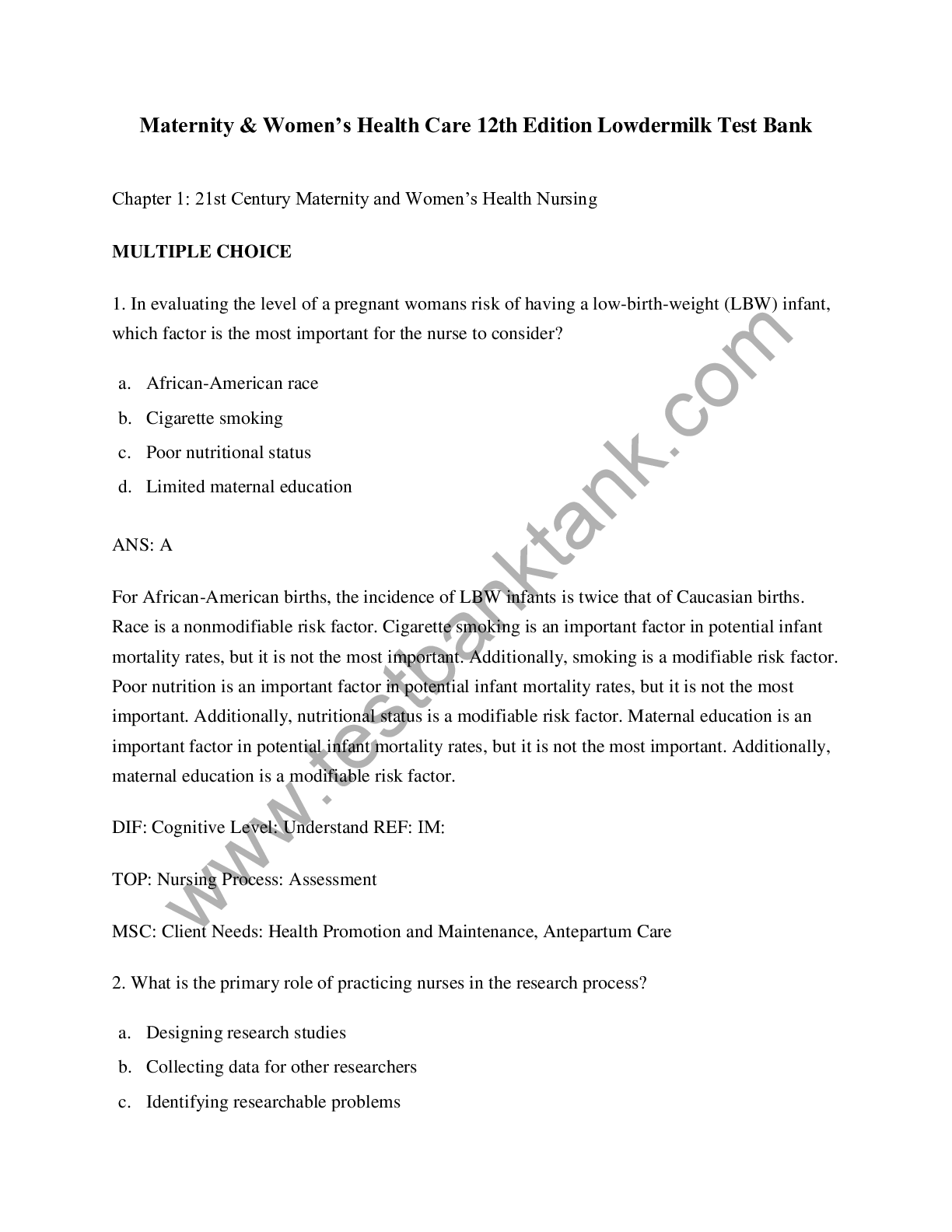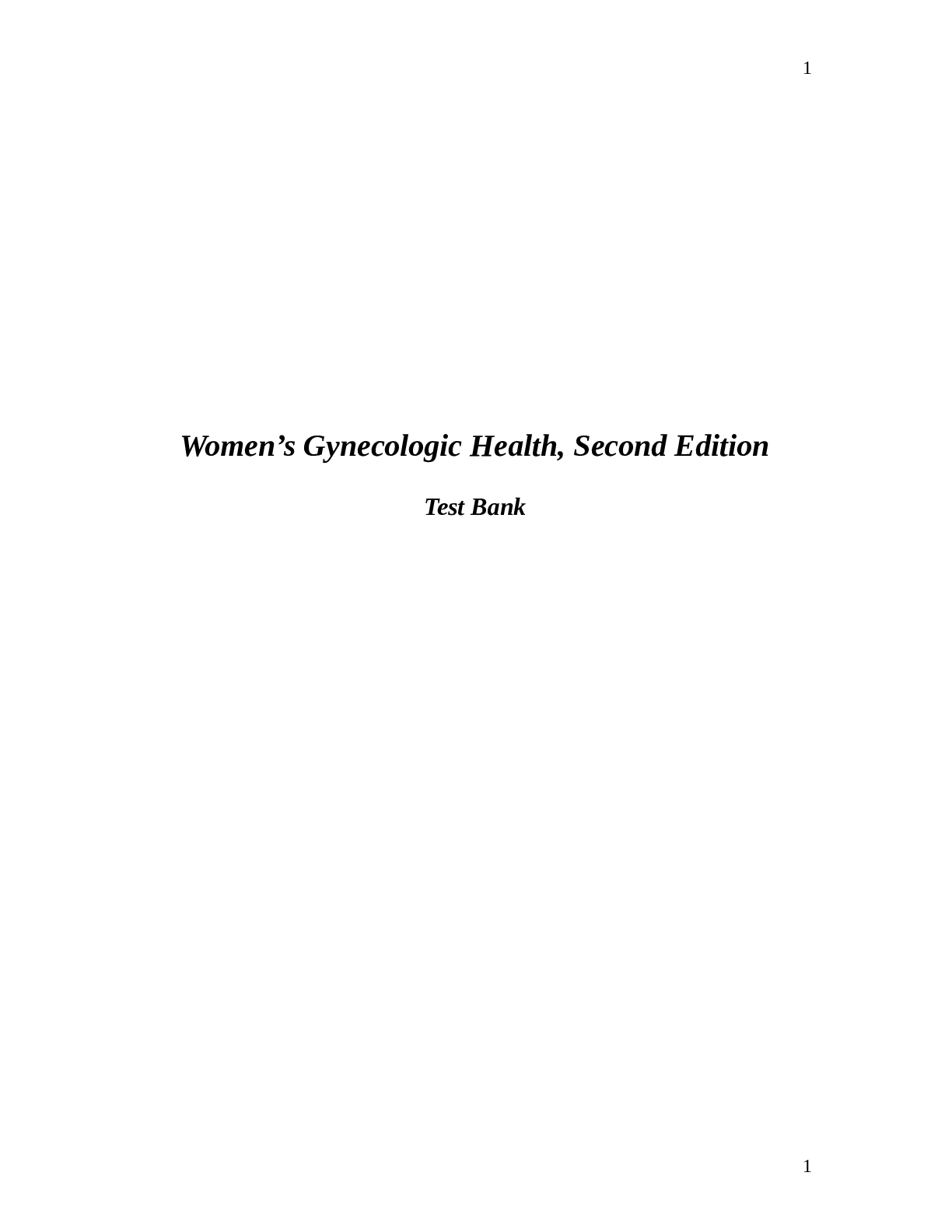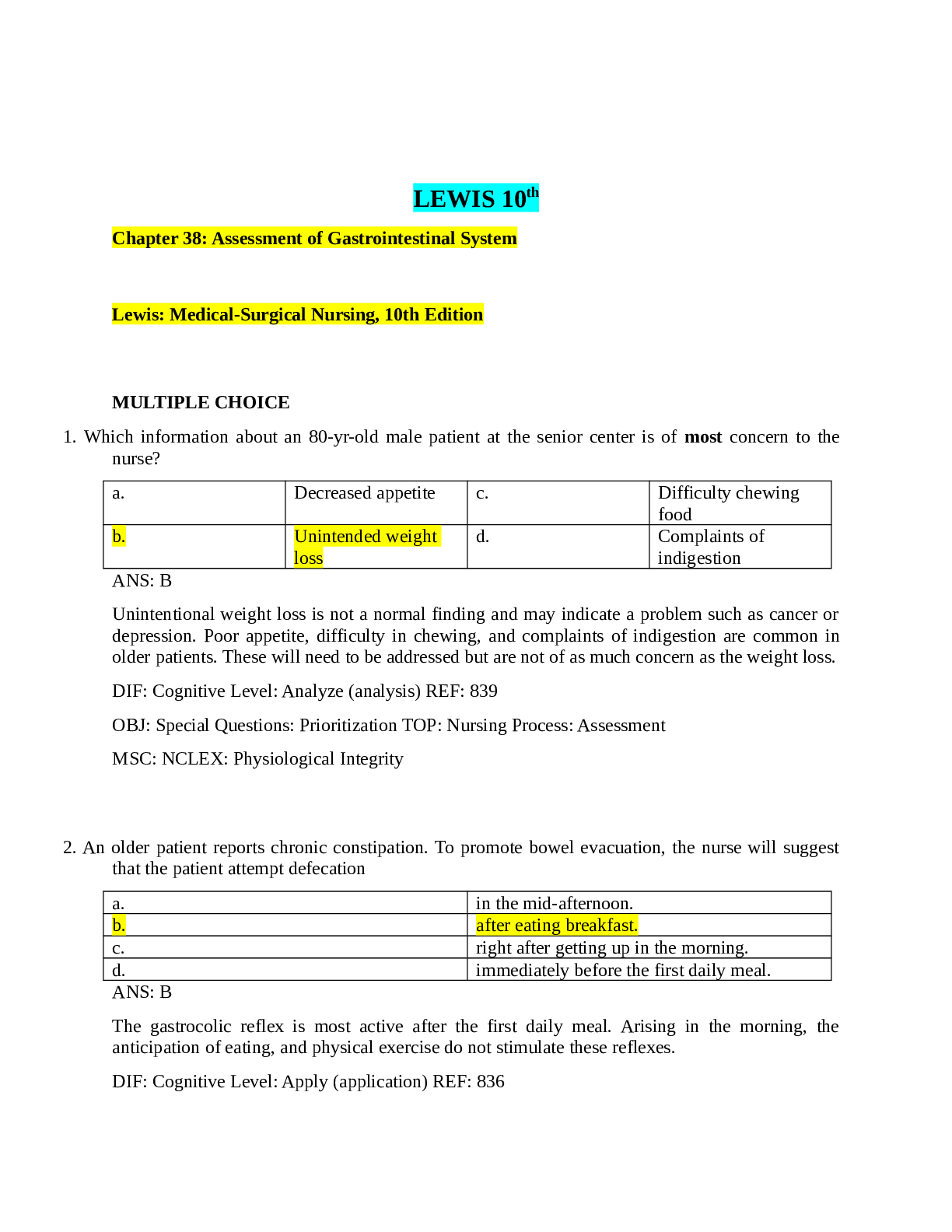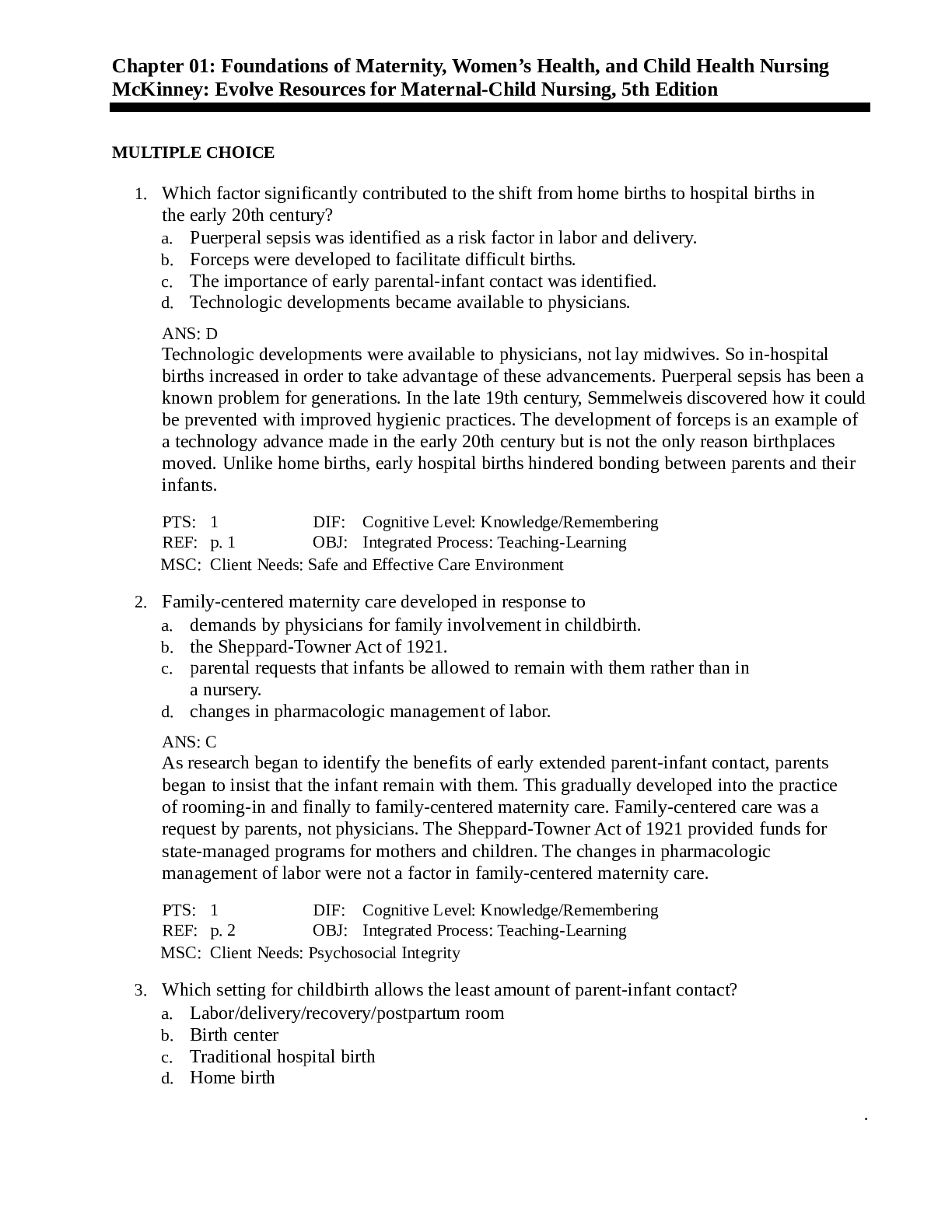*NURSING > TEST BANKS > Understanding Research Findings Test Bank Q&A Graded A+ (All)
Understanding Research Findings Test Bank Q&A Graded A+
Document Content and Description Below
MULTIPLE CHOICE 1. The results section of a research report includes what? a. Instruments b. Data c. Design d. Theory ANS: B Feedback A Instruments are referred to in the methods section. B T... he results section of a research report is considered the data-bound section of the report. C Design fits into the methods section. D Theory is frequently referred to in the literature review section. DIF: Cognitive Level: Understanding (Comprehension) REF: Page 335-337 2. If a study’s results are not supported statistically or are only partially supported, research consumers should conclude that the study is what? a. Irrelevant b. Important to review c. Proven d. Unconfirmed ANS: B Feedback A The study is important; information from unsupported studies can often be useful. B The study is worth reviewing; information from unsupported studies can often be useful. C Statistical study results do not prove hypotheses; hypotheses that are not supported by statistical tests provide useful information. D This answer does not define the usefulness of a study. DIF: Cognitive Level: Understanding (Comprehension) REF: Page 337 3. Which section of the report allows a nurse researcher to review critical summary numbers for each test? a. Results b. Discussion c. Literature review d. Methods ANS: A Feedback A The results section will allow the nurse researcher to review critical summary numbers for each test. B The discussion section will not allow the nurse researcher to review critical summary numbers for each test. C The literature review will not allow the nurse researcher to review critical summary numbers for each test. D The methods section will not allow the nurse researcher to review critical summary numbers for each test. DIF: Cognitive Level: Remembering (Knowledge) REF: Page 338 4. Which section of the report allows a nurse researcher to review reduction of data in the form of tables and figures? a. Results b. Discussion c. Literature review d. Methods ANS: A Feedback A The results section will allow the nurse researcher to review reduction of data in the form of tables and figures. B The discussion section will not allow the nurse researcher to review reduction of data in the form of tables and figures. C The literature review will not allow the nurse researcher to review reduction of data in the form of tables and figures. D The methods section will not allow the nurse researcher to review reduction of data in the form of tables and figures. DIF: Cognitive Level: Remembering (Knowledge) REF: Page 338 5. Which section of the report allows a nurse researcher to report unforeseen events that occurred during the course of the study? a. Results b. Discussion c. Literature review d. Methods ANS: A Feedback A The results section will allow the nurse researcher to report untoward events that occurred during the course of the study. B The discussion section will not allow the nurse researcher to report untoward events that occurred during the course of the study. C The literature review will not allow the nurse researcher to report untoward events that occurred during the course of the study. D The methods section will not allow the nurse researcher to report untoward events that occurred during the course of the study. DIF: Cognitive Level: Remembering (Knowledge) REF: Page 338 6. Which section of the report allows a nurse researcher to review all data, including data that are not significant? a. Results b. Discussion c. Literature review d. Methods ANS: A Feedback A The results section will allow the nurse researcher to review all data, even data that are not significant. B The discussion section will not allow the nurse researcher to review all data, even data that are not significant. C The literature review will not allow the nurse researcher to review all data, even data that are not significant. D The methods section will not allow the nurse researcher to review all data, even data that are not significant. DIF: Cognitive Level: Remembering (Knowledge) REF: Page 338 7. Which section of the report allows the nurse researcher to address limitations or weaknesses of the study? a. Results b. Discussion c. Literature review d. Methods ANS: B Feedback A The results section does not include addressing limitations or weaknesses. B Limitations or weaknesses of the study are addressed in the discussion section. C The literature review does not include addressing limitations or weaknesses. D The methods section does not include addressing limitations or weaknesses. DIF: Cognitive Level: Remembering (Knowledge) REF: Page 340 8. Which section of the report will allow the nurse researcher to determine what contribution the study makes to nursing? a. Results b. Discussion c. Recommendations d. Methods ANS: C Feedback A The results section does not allow the nurse researcher to answer the question “What contribution to nursing does this study make?” B The discussion section does not allow the nurse researcher to answer the question “What contribution to nursing does this study make?” C The recommendations section allows the nurse researcher to answer the question “What contribution to nursing does this study make?” D The methods section does not allow the nurse researcher to answer the question “What contribution to nursing does this study make?” DIF: Cognitive Level: Applying (Application) REF: Page 342-343 9. Which section of the report will allow the nurse researcher to determine the strength, quality, and consistency of the evidence provided by the findings? a. Results b. Discussion c. Recommendations d. Methods ANS: C Feedback A The results section does not allow the nurse researcher to answer the question “What are the strength, quality, and consistency of the evidence provided by the findings?” B The discussion section does not allow the nurse researcher to answer the question “What are the strength, quality, and consistency of the evidence provided by the findings?” C The recommendations section allows the nurse researcher to answer the question “What are the strength, quality, and consistency of the evidence provided by the findings?” D The methods section does not allow the nurse researcher to answer the question “What are the strength, quality, and consistency of the evidence provided by the findings?” DIF: Cognitive Level: Applying (Application) REF: Page 342-343 10. Which section of the report allows the researcher to determine if evidence provided in the findings validates current practice or supports the need for change? a. Results b. Discussion c. Recommendations d. Methods ANS: C Feedback A The results section does not allow the nurse researcher to answer the question “Does the evidence provided in the findings validate current practice or support the need for change in practice?” B The discussion section does not allow the nurse researcher to answer the question “Does the evidence provided in the findings validate current practice or support the need for change in practice?” C The recommendations section allows the nurse researcher to answer the question “Does the evidence provided in the findings validate current practice or support the need for change in practice?” D The methods section does not allow the nurse researcher to answer the question “Does the evidence provided in the findings validate current practice or support the need for change in practice?” [Show More]
Last updated: 2 years ago
Preview 1 out of 14 pages

Buy this document to get the full access instantly
Instant Download Access after purchase
Buy NowInstant download
We Accept:

Reviews( 0 )
$12.00
Can't find what you want? Try our AI powered Search
Document information
Connected school, study & course
About the document
Uploaded On
Sep 01, 2021
Number of pages
14
Written in
Additional information
This document has been written for:
Uploaded
Sep 01, 2021
Downloads
0
Views
84



.png)






.png)


 (1).png)

